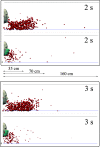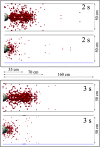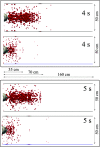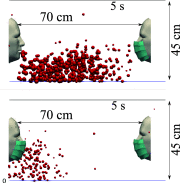On respiratory droplets and face masks
- PMID: 32574231
- PMCID: PMC7301882
- DOI: 10.1063/5.0015044
On respiratory droplets and face masks
Abstract
Face mask filters-textile, surgical, or respiratory-are widely used in an effort to limit the spread of airborne viral infections. Our understanding of the droplet dynamics around a face mask filter, including the droplet containment and leakage from and passing through the cover, is incomplete. We present a fluid dynamics study of the transmission of respiratory droplets through and around a face mask filter. By employing multiphase computational fluid dynamics in a fully coupled Eulerian-Lagrangian framework, we investigate the droplet dynamics induced by a mild coughing incident and examine the fluid dynamics phenomena affecting the mask efficiency. The model takes into account turbulent dispersion forces, droplet phase-change, evaporation, and breakup in addition to the droplet-droplet and droplet-air interactions. The model mimics real events by using data, which closely resemble cough experiments. The study shows that the criteria employed for assessing the face mask performance must be modified to take into account the penetration dynamics of airborne droplet transmission, the fluid dynamics leakage around the filter, and reduction of efficiency during cough cycles. A new criterion for calculating more accurately the mask efficiency by taking into account the penetration dynamics is proposed. We show that the use of masks will reduce the airborne droplet transmission and will also protect the wearer from the droplets expelled from other subjects. However, many droplets still spread around and away from the cover, cumulatively, during cough cycles. Therefore, the use of a mask does not provide complete protection, and social distancing remains important during a pandemic. The implications of the reduced mask efficiency and respiratory droplet transmission away from the mask are even more critical for healthcare workers. The results of this study provide evidence of droplet transmission prevention by face masks, which can guide their use and further improvement.
Copyright © 2020 Author(s).
Figures



















References
-
- Yan J., Grantham M., Pantelic J., de Mesquita P. J. B., Albert B., Liu F., Ehrman S., Milton D. K., and Consortium E., “Infectious virus in exhaled breath of symptomatic seasonal influenza cases from a college community,” Proc. Natl. Acad. Sci. U. S. A. 115(5), 1081–1086 (2018).10.1073/pnas.1716561115 - DOI - PMC - PubMed
LinkOut - more resources
Full Text Sources
Other Literature Sources
